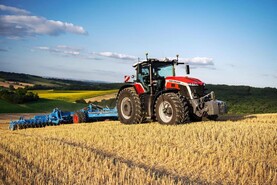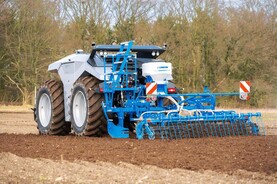The days of blanket crop protection and nutrition applications by humans are numbered, while the era of precision treatments by robots is here. This was one of the common visions shared by the many farm robotics companies who attended the recent Future Farm Technology Expo in Birmingham UK.
This new level of precision agriculture will be achieved through the use of autonomous farm robots collecting data from every square inch of a field before applying a treatment tailored to individual plants.
Farm robots are set to change tillage farming fundamentally. Currently there are over 40 companies around the world working on developing farm robots, including Ireland’s own Acres Machinery, which took Agritechnica by storm with its driverless smart tractor iTerra.
Each company’s vision differs. Some are banking on retrofitting existing farm machinery to work autonomously, while others have designed a new generation of light and compact farm machinery which work in swarms and are equipped with artificial intelligence software.
While some of these technologies are still a number of years away from Irish fields, many have products working around the world. We spoke to three of robotics companies.
Listen to “Autonomous farm robots on the markets today.” on Spreaker.
The Small Robot Company designs and builds autonomous farm robots capable of scouting, sowing and weeding tillage fields. The robots are compact and weigh 200-400kg.

Tom is a scouting Robot and collects data from the fields.
The company has three robots so far – Tom, Dick and Harry. Tom is a monitoring robot and scouts the fields, collecting data on plants and weeds. It can cover around 20ha per day.
This data is processed into instructions which are sent to Dick and Harry. Dick is capable of treating each plant individually and kill weeds by non-chemical means. Harry is a planting robot which can plant seeds without significantly disturbing the soil.
The robots will be available on a “farming as a service” model. Farmers won’t own the robots, but rather pay a fee per ha for their use.
The current broad-leaved weed mapping service costs £15/ha. By next year, a grassweed mapping service will be available at £40/ha. Over the next year and a half, they will have their weedkilling service for around £150/ha.
Vision: “By reducing inputs, reducing damage to the soil and using our farming as a service model, we think farmers will start to make a profit again,” explains Ben.
Listen to “Robotic weed mapping for £15/ha” on Spreaker.
Started in 2012, French-based NAIO technologies develops and markets robots for agriculture and viticulture. We spoke to VP of business sales Richard Swift, who explained that the focus of their robotic range is primarily on weeding, hoeing and monitoring plants. They currently have three robots in their range – Oz, Dino and Ted.
Oz is a small robot designed for market gardeners and small vegetable growers to weed and help with the harvest.

Dino is designed for large scale vegetable weeding.
Dino is designed to weed large-scale vegetable farms. It has been on the market since early 2017 and more than 20 robots are now working across France and in Europe.
Ted is a weeding robot specially designed for weeding vineyards and is in the prototype stage.
Vision: “One of our big drivers is to find solutions to the labour situation. Producers can’t find people to weed or drive tractors. Our robots will be fully autonomous,” remarks Richard.
Listen to “Thorvald, a modular robot for fields, tunnels, orchards and glasshouses” on Spreaker.
Thorvald is an autonomous modular robot that can be configured for work in open fields, tunnels, orchards and greenhouses. Manufactured by Saga Robotics, the robot can be made into numerous different shapes and sizes.
We spoke with Michael Hutchinson, Robotics Engineer who explained that this robot is mainly in use in strawberry farms where the crop is treated with UVC light for mildew control. The robot is also capable of in-field transportation, cutting grass for forage, spraying and data collection and crop prediction.
The battery powered robot can run for up to 24hrs and uses RTK GPS and lidar systems for guidance. Thorvald is not commercially available yet but will soon be sold as a service. By 2020 there will be 10-30 robots out on farms on trial before being commercially available by 2021.
Vision: “For the next few years we’ll be focusing on soft fruit. But in the long term I can see it taking over tractors totally.” Michael explained.
Read more
Grain prices: futures dance but physicals firm
IFA potato report: little progress made in the fields
The days of blanket crop protection and nutrition applications by humans are numbered, while the era of precision treatments by robots is here. This was one of the common visions shared by the many farm robotics companies who attended the recent Future Farm Technology Expo in Birmingham UK.
This new level of precision agriculture will be achieved through the use of autonomous farm robots collecting data from every square inch of a field before applying a treatment tailored to individual plants.
Farm robots are set to change tillage farming fundamentally. Currently there are over 40 companies around the world working on developing farm robots, including Ireland’s own Acres Machinery, which took Agritechnica by storm with its driverless smart tractor iTerra.
Each company’s vision differs. Some are banking on retrofitting existing farm machinery to work autonomously, while others have designed a new generation of light and compact farm machinery which work in swarms and are equipped with artificial intelligence software.
While some of these technologies are still a number of years away from Irish fields, many have products working around the world. We spoke to three of robotics companies.
Listen to “Autonomous farm robots on the markets today.” on Spreaker.
The Small Robot Company designs and builds autonomous farm robots capable of scouting, sowing and weeding tillage fields. The robots are compact and weigh 200-400kg.

Tom is a scouting Robot and collects data from the fields.
The company has three robots so far – Tom, Dick and Harry. Tom is a monitoring robot and scouts the fields, collecting data on plants and weeds. It can cover around 20ha per day.
This data is processed into instructions which are sent to Dick and Harry. Dick is capable of treating each plant individually and kill weeds by non-chemical means. Harry is a planting robot which can plant seeds without significantly disturbing the soil.
The robots will be available on a “farming as a service” model. Farmers won’t own the robots, but rather pay a fee per ha for their use.
The current broad-leaved weed mapping service costs £15/ha. By next year, a grassweed mapping service will be available at £40/ha. Over the next year and a half, they will have their weedkilling service for around £150/ha.
Vision: “By reducing inputs, reducing damage to the soil and using our farming as a service model, we think farmers will start to make a profit again,” explains Ben.
Listen to “Robotic weed mapping for £15/ha” on Spreaker.
Started in 2012, French-based NAIO technologies develops and markets robots for agriculture and viticulture. We spoke to VP of business sales Richard Swift, who explained that the focus of their robotic range is primarily on weeding, hoeing and monitoring plants. They currently have three robots in their range – Oz, Dino and Ted.
Oz is a small robot designed for market gardeners and small vegetable growers to weed and help with the harvest.

Dino is designed for large scale vegetable weeding.
Dino is designed to weed large-scale vegetable farms. It has been on the market since early 2017 and more than 20 robots are now working across France and in Europe.
Ted is a weeding robot specially designed for weeding vineyards and is in the prototype stage.
Vision: “One of our big drivers is to find solutions to the labour situation. Producers can’t find people to weed or drive tractors. Our robots will be fully autonomous,” remarks Richard.
Listen to “Thorvald, a modular robot for fields, tunnels, orchards and glasshouses” on Spreaker.
Thorvald is an autonomous modular robot that can be configured for work in open fields, tunnels, orchards and greenhouses. Manufactured by Saga Robotics, the robot can be made into numerous different shapes and sizes.
We spoke with Michael Hutchinson, Robotics Engineer who explained that this robot is mainly in use in strawberry farms where the crop is treated with UVC light for mildew control. The robot is also capable of in-field transportation, cutting grass for forage, spraying and data collection and crop prediction.
The battery powered robot can run for up to 24hrs and uses RTK GPS and lidar systems for guidance. Thorvald is not commercially available yet but will soon be sold as a service. By 2020 there will be 10-30 robots out on farms on trial before being commercially available by 2021.
Vision: “For the next few years we’ll be focusing on soft fruit. But in the long term I can see it taking over tractors totally.” Michael explained.
Read more
Grain prices: futures dance but physicals firm
IFA potato report: little progress made in the fields








 This is a subscriber-only article
This is a subscriber-only article









SHARING OPTIONS: